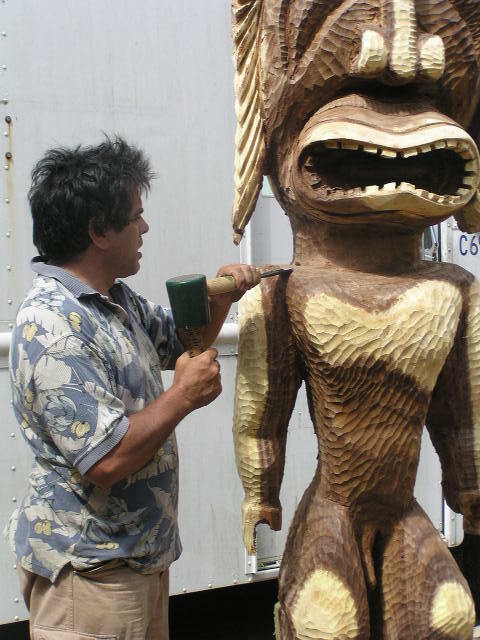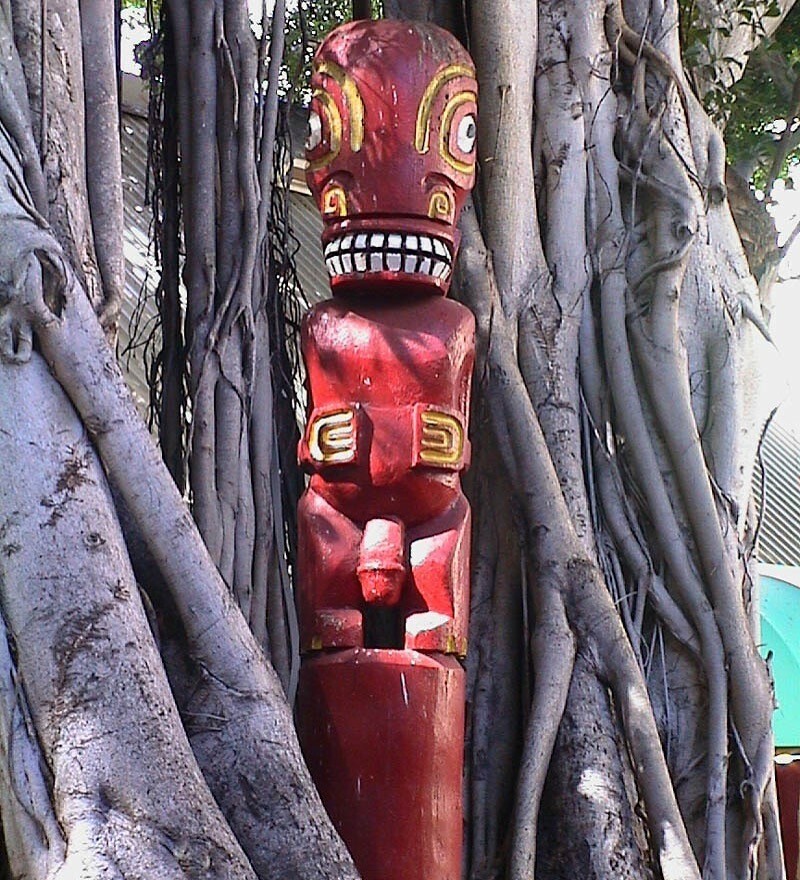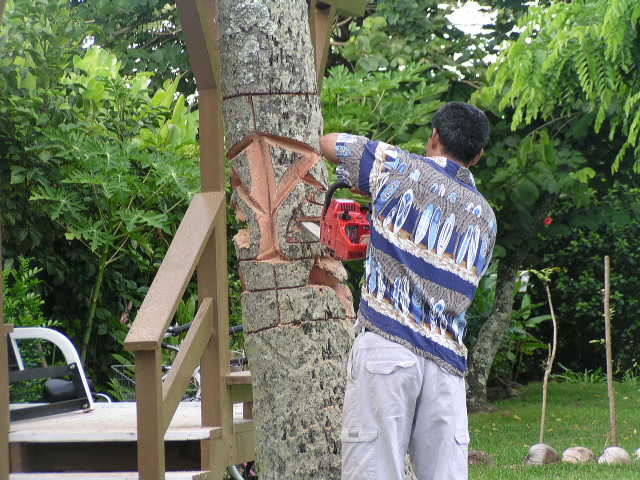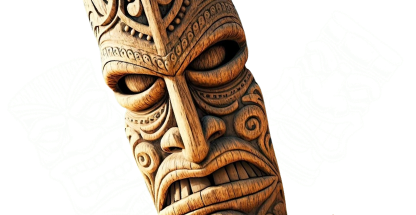Tiki statues symbolize Polynesian culture and connect to vacations and tiki bars. But where did these iconic wooden statues originate from? In this article, we'll explore the history of hand carved tiki statues and their significance in Polynesian art.

The Origins of Tiki Statues
The word "tiki" comes from the Maori language of New Zealand and refers to the first man created by the gods. In Polynesian mythology, people also know tiki as the god of fertility and the creator of the first woman. People originally created Tiki statues as a representation of this god and used them in religious ceremonies and rituals.

The Maori people of New Zealand carved the first tiki statues, using them as talismans for protection and good luck. People often made statues from wood or stone, carving them with symbols and designs that held spiritual significance.
The Spread of Tiki Culture
As Polynesian culture spread throughout the Pacific islands, so did the use of tiki statues. Each island had different carvings, but they were all used to honor gods and bring luck.
In Hawaii, people called tiki statues "ki'i" and used them in religious ceremonies to communicate with the gods. Artisans often carved the statues from koa wood and adorned them with feathers, shells, and other natural materials.

In Tahiti, individuals referred to tiki statues as "tiki marae" and utilized them as protectors of holy areas. People positioned these large tiki statues at the entrances of temples and significant locations.
The Rise of Tiki Culture in the United States
In the 1930s, tiki culture began to gain popularity in the United States. This was due in part to the opening of Don the Beachcomber, a tiki-themed restaurant in Hollywood. The eatery, adorned with tropical decorations, unique beverages, and intricately hand-sculpted tiki figures, rapidly gained popularity among patrons.

During World War II, American soldiers in the Pacific brought back tiki souvenirs like statues. This helped increase the popularity of tiki culture in the United States. Tiki bars and restaurants began popping up all over the country, and the trend continued into the 1950s and 1960s.
The Influence of Tiki Culture on Art and Design
Tiki culture in the mid-20th century greatly influenced art and design in different ways. Polynesian art pieces, particularly Tiki statues, became highly sought after as decorative elements for homes, businesses, and public spaces.
Artisans typically made these statues from wood or stone. They depicted human figures with bold features. People believed that these statues had spiritual and protective powers.
Besides Tiki statues, Polynesian art like tapa cloth, Maori carvings, and Hawaiian quilts became popular during this period. Art forms enhanced interior design, fashion, and architecture to create a more exotic and adventurous everyday life.

The influence of tiki culture on design extended beyond just art objects. Tiki designs were popular in graphic design, ads, and packaging during the mid-1900s. These designs combined Polynesian culture with modern design, creating a unique style.
Tiki culture's popularity had a lasting impact on art and design, influencing trends that still resonate with audiences today.
Trader Vic is well-known for its distinctive art deco style and mai tai cocktails. These cocktails have been a favorite in American culture for more than fifty years.

Artists Leroy Schmaltz and Shag create tiki-themed artwork that is well-known. Their pieces feature bright colors and fun images of tiki statues and tropical settings.
The Modern Day Tiki Revival
In recent years, there has been a resurgence of interest in tiki culture and the art of hand carving tiki statues. Tiki bars and eateries are back in vogue. Artists and craftsmen are making their own tiki statues and carvings.
Danny Gallardo, also known as Tiki Diablo, carves tiki statues by hand and has been doing so for over 20 years. Tiki bars and restaurants around the world have featured his work, and he has become a leader in the modern tiki revival.
The Significance of Hand Carved Tiki Statues
In Polynesian culture, people revere hand-carved tiki statues for their deep spiritual significance and cultural importance. These statues are not just decorative pieces, but rather symbols of ancestral connections, protection, and spiritual guidance. Each statue is a unique piece of art made by skilled artisans trained in traditional techniques passed down through generations.

The act of sculpting a tiki statue is a unique ceremony. The sculptor contemplates and bonds with the spiritual essence of the wood prior to starting the carving process. Artisans choose wood for carving based on its strength, durability, and spiritual qualities. Some believe that certain types of wood possess unique energies and powers.
Tiki statues have different designs based on region and beliefs, each symbol and motif having its own special meaning. Some statues may represent gods or deities, while others may depict ancestors or guardians. The carvings on each statue are not just for looks, but also have spiritual meaning and symbolism.
People often use Tiki statues in ceremonies, rituals, and celebrations to honor ancestors, seek protection, or invoke blessings. Many people believe that crystals bridge the physical world and the spiritual realm. They connect the living with the divine. Tiki statues are important for keeping and sharing the cultural traditions of the Polynesian people.
Making a tiki statue is a special tradition passed down through generations using old tools and techniques. Artisans carefully choose wood for carving, believing that different types have special spiritual qualities.
How to Incorporate Tiki Statues into Your Home Decor
Hand carved tiki statues are a beautiful and unique way to bring a touch of Polynesian culture into your home. Artisans typically make these statues from wood and incorporate intricate designs and symbols that hold significance in Polynesian culture. Tiki statues link Hawaiian and Maori cultures, bringing a touch of mystery and oddity to any area.

Statues come in different sizes, from small decorations to larger pieces that can be a focal point in a room. You can place them indoors or outdoors, depending on your preference, and they can add a touch of warmth and character to any space.
In addition to their aesthetic appeal, tiki statues can also hold symbolic meaning. In Polynesian culture, people use tiki statues to symbolize gods and ancestors in rituals and ceremonies. Add Polynesian statues to your home decor to connect with their history and traditions.
If you collect cultural items or want a special decoration for your home, consider hand carved tiki statues. They are unique and eye-catching. They can bring a sense of marvel and adventure to your space, and serve as a conversation starter for guests.
So why not consider adding a touch of Polynesian culture to your home with a hand carved tiki statue today? You can position these sculptures on ledges, fireplace tops, or mount them on walls. They are unique pieces from the South Pacific and French Polynesia.
Tiki sculptures are a favored option for infusing a bit of tropical charm into open-air areas. These statues, often carved from wood or stone, can range in size from small tabletop decorations to larger-than-life sculptures. Adding tiki statues to your pool or garden can transform your backyard into a tranquil oasis. This will provide you with the feeling of being on a tropical vacation.
The whimsical and exotic designs of tiki statues can bring a sense of fun and adventure to your outdoor decor. Choose between traditional Hawaiian tikis or modern interpretations for a statement in your outdoor space. Tikis can have fierce expressions and intricate carvings or bright colors and playful motifs.
In addition to their aesthetic appeal, tiki statues can also serve a functional purpose. Adding tiki torches or lights by your tiki statues can make your outdoor gatherings or evening relaxation more cozy. Use tiki statues as focal points in your outdoor design. Strategically place them to draw the eye and create visual interest.

Adding tiki statues to your outdoor area is a fun way to bring a tropical feel to your backyard. Tiki statues can help you create a peaceful or fun outdoor space for relaxing or entertaining. They are perfect for achieving the ideal outdoor oasis.
The Future of Tiki Culture
As tiki culture continues to gain popularity, the future of hand carved tiki statues looks bright. Artists and craftsmen are making new versions of tiki statues, keeping the tradition alive. They honor the history and culture of these carvings while adding their own modern twist.
Tiki statues have made quite an impact on art, design, and popular culture. Whether you love tiki culture or appreciate the artistry of tiki statues, it's clear how influential they have been.
Visit Tikimaster.com, Kailua Oahu for the largest tiki art gallery on display.




